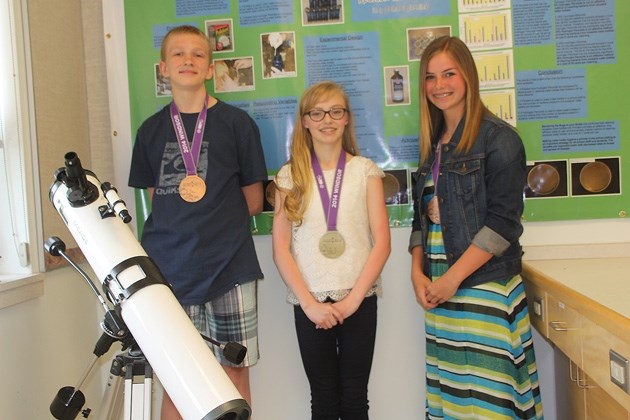The things that are done in the name of science.
Red Deer Lake student Brielle Lillywhite won a gold medal at the Canada Wide Science Fair for her exhibit which included sticking her arm in a box filled with mosquitoes.
Her experiment was to determine whether certain colours of fabric cause greater attraction for mosquitoes.
“In the summer I get bitten really badly and it’s like an allergic reaction,” Lillywhite said. “Also, I have family and friends who were getting their immunization for malaria because they are traveling to Africa. They were told to wear light clothing and I wanted to see if that was true.”
Lillywhite was one of three Grade 8 Red Deer Lake students who caught the science fair bug. Ryan Peters and Stephanie Dunham won bronze medals for their respective projects at the fair in Windsor, Ont. on May 10-17.
Lillywhite’s experiment included a flexiglass tank with two tubes, which she would stick her arms through. Each tube had different colour fabrics at the end, one beige the other dark blue. The tank also has 150 mosquitoes from her backyard sucked into a shop vacuum. She stuck her arms in the tubes for 35 minutes for seven consecutive days.
“I video recorded it and I would put it on my computer and record how many mosquitoes had landed on my arms,” she said. “I found there was no difference between the two colours – that mosquitoes aren’t attracted to darker hue fabrics.”
She also learned scientists are allowed to be wrong. Her hypothesis was the darker colours would attract more mosquitoes.
Meanwhile Peters had the judges hanging by a rope with anticipation with his experiment.
“Mine was testing the tensile strength of rope and what certain kind of knots would increase the tensile strength of a rope,” Peters said.
He got the idea from his dad, an avid climber.
“It’s important for climbers to know what factors go into tensile strength,” Peters said.
“I found out that knots do indeed decrease a rope’s tensile strength when they have been tied or untied and that a knot called the Alpine butterfly decreases the tensile strength the least.”
Peters’ testing had an apparatus with a movable box. The box would be lifted using clamps and a pump handle, putting stress on the rope. A scale would measure the amount of weight the ropes were withstanding.
Dunham took home the bronze medal by determining the effectiveness of SPF (sun protection factor) in certain sunscreens. Her inspiration came from grandfather who recently had a cancerous skin spot removed.
She purchased some ultraviolet reading beads, which were placed in Ziploc-like bags. Each of the bags were then covered with a sunscreen lotion. The baggies were exposed to ultraviolet rays.
Dunham was able to measure the amount of ultraviolet light based on the colour of the beads.
“My conclusion was Banana Boat 50 was the most effective sunscreen (of the nine she used), Dunham said.
Her hypothesis was based on Banana Boat 50 having healthy amounts of homosalate, which is a sun-blocking agent.
Red Deer Lake School has been the 1980s Edmonton Oilers of the national science fair. They have had strong showings at the fair for several years. However, this was the first year all of the Red Deer Lake School qualifiers have come home with a medal.
Red Deer Lake School teacher Derek Dubs said science fairs taken in many components of education.
“Science is all about inquiry learning,” Dubs said. “Science fair takes the students from research to applying their ideas to end product and conclusion… Which is what science fair is all about.”
It also has the students using language arts, math schools and verbal skills as they prepare and present their exhibits.
Lillywhite received $700 and a $4,000 scholarship to Western Ontario University if she chooses to attend school there. Peters and Dunham picked up $100 and $1,000 scholarship to WOU.




